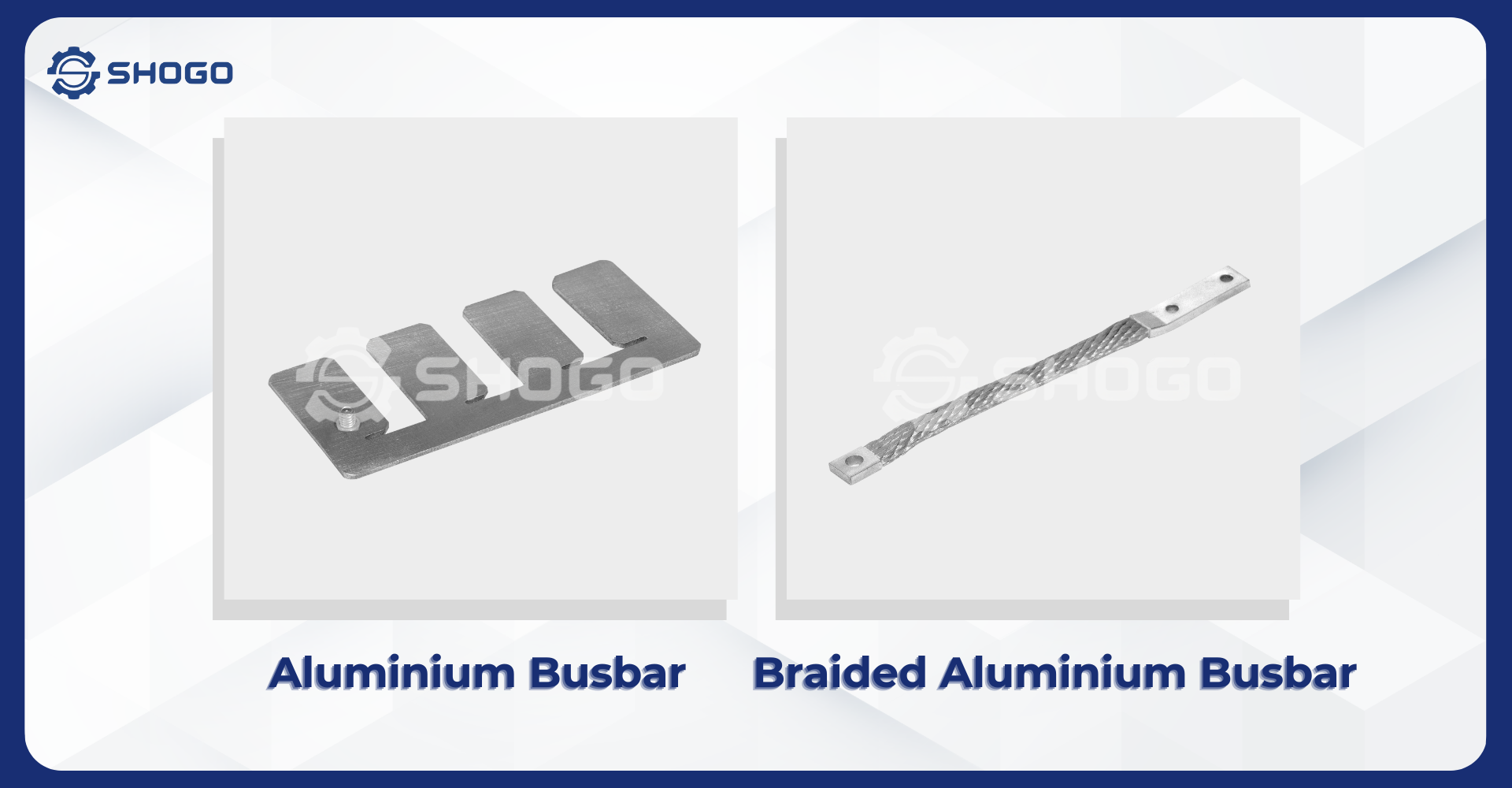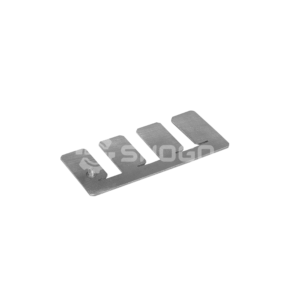
Busbars play an important role in the electrical system, responsible for conducting and distributing electricity from the source to consuming devices. Today, the two most common types of busbars are aluminum busbars and braided aluminum busbars. This article will compare these two types of busbars in detail in terms of materials, structure, advantages, disadvantages, applications, and prices, thereby helping you make the appropriate choice for your electrical system. mine.
1. Structural materials
Aluminum busbars:

- Made from pure aluminum or aluminum alloy, it stands out with the advantages of lightness, ease of processing and low price.
- However, the electrical conductivity of aluminum is lower than that of copper, resulting in a larger aluminum busbar size to achieve the same electrical conductivity compared to copper busbars.
- Aluminum is easily oxidized if not stored properly, affecting electrical conductivity and longevity.
Braided aluminum busbars:

- Using many small aluminum fibers braided together, creating a flexible structure and higher electrical conductivity than conventional aluminum bus bars.
- Disadvantages of braided aluminum busbars are higher cost and higher processing difficulty due to complex structure.
- Besides, the braided aluminum busbar is easily broken if subjected to strong impact.
2. Structure
Aluminum busbars:
-
- Has a simple structure consisting of a long, flat or I-shaped aluminum bar.
- The size and shape of the aluminum busbar depends on the electrical conductivity and load requirements.
Braided aluminum busbars:
-
- The structure is more complex with many small aluminum fibers tightly braided together.
- The amount of aluminum fibers, braiding method and braiding material affect the conductivity, flexibility and durability of braided aluminum busbars.
3. Advantages and disadvantages
Aluminum busbar:
Advantage:
- Light weight, easy to transport and install.
- Cheaper price than braided aluminum busbars.
- Withstands harsh environments, good corrosion resistance.
- Easy to process, can be bent into many different shapes.
Defect:
- Lower electrical conductivity compared to copper bus bars.
- Larger size compared to copper bus bars with the same electrical conductivity.
- Easily oxidized if not stored properly.
Braided aluminum busbar:
Advantage:
- Higher electrical conductivity compared to aluminum bus bars.
- High flexibility, easy to install in tight spaces.
- Less susceptible to electromagnetic interference.
- Withstand high loads.
Defect:
- Higher cost compared to aluminum bus bars.
- More difficult to process than aluminum bus bars.
- May break if subjected to strong impact.
| Criterion | Aluminum Busbars | Braid Busbars |
| Material | Pure aluminum or aluminum alloys | Multiple small aluminum strands braided together |
| Construction | Simple, consisting of a single long aluminum bar | Complex, with numerous tightly braided aluminum strands |
| Advantages | Lightweight, easy to process, low cost, withstands harsh environments | High conductivity, flexible, low electromagnetic interference (EMI), high load-bearing capacity |
| Disadvantages | Low conductivity, large size, prone to oxidation | High cost, difficult to process, susceptible to breakage |
| Applications | Factory, plant, and substation electrical systems | High-voltage electrical systems, electronics, automation, ships, and aircraft |
| Cost | Low | High |
4. Application
Aluminum Busbars:
- Widely used in electrical systems of workshops, factories, transformer stations,…
- Suitable for electrical systems that require cost and ease of installation.
Braid Busbars:
- Used in high voltage power systems, electronic and automation systems, electrical systems on ships, aircraft,…
- Priority for use in electrical systems with high requirements for conductivity, flexibility and anti-interference.
5. Price
- Aluminum busbar: cheaper than braided aluminum busbar.
- Braided aluminum busbars: have a higher cost than aluminum busbars due to their complex structure and higher quality materials.
6. Choose the appropriate busbar type
Choosing which type of busbar depends on many factors such as:
- Electrical conductivity requirements: Does the electrical system need high load?
- Load: How much load does the electrical system need to withstand?
- Flexibility: Need to install the busbar in the air
- Environment: In what environment does the electrical system operate?
- Cost: What is the budget estimate for the electrical system?
Below are some suggestions for choosing the right busbar:
- Electrical systems for workshops, factories, and transformer stations: Aluminum busbars should be used to save costs and make installation easier.
- High voltage electrical systems, electronic and automation systems, electrical systems on ships and aircraft: Braided aluminum busbars should be used to ensure high conductivity, flexibility and anti-interference.
- Electrical systems operating in harsh environments: Aluminum bus bars with protective coating should be used to prevent corrosion.
Note: You should consult an electrical engineer to choose the most suitable type of busbar for your electrical system.
7. Some notes when using aluminum bus bars and braided aluminum bus bars
- Technical standards must be followed during busbar installation and operation.
- Use specialized tools to construct busbars, ensuring safety and efficiency.
- Regularly check and periodically maintain the busbar to ensure best operation.
Conclude
Aluminum busbars and braided aluminum busbars both have their own advantages and disadvantages. Choosing the appropriate type of busbar depends on many factors such as electrical system requirements, environmental conditions and budget. Hopefully this article has provided you with useful information to choose the right type of busbar for your electrical system.
Why choose SHOGO Viet Nam?
1. Quality Commitment: SHOGO Viet Nam.,JSC is the No. 1 Busbar and Cable manufacturer in Viet Nam for the new energy industry. We are committed to providing our customers with products of the highest quality standards. All raw materials are inspected for quality before production, and 100% of products are thoroughly inspected before delivery. SHOGO Viet Nam holds prestigious certificates: IATF16949-2016, ISO 9001-2015, ISO 14001-2015, ISO/IEC 17025-2017,…
2. Competitive Pricing: With a team of experienced engineers who have participated in many electric vehicle production projects, SHOGO Viet Nam can provide product consulting to help customers optimize production costs and improve product quality. With a geographical location that is convenient for trading, along with modern machinery and technology, SHOGO Viet Nam can provide products at the most competitive prices on the market.
3. Dedicated Service: With a team of experienced employees, large production capacity and reasonable supply, SHOGO Viet Nam always ensures on-time delivery for customers. Support customers in all projects, quickly handle arising problems.
You can refer to some of our Busbar products on the page “PRODUCTS“.
To receive FREE CONSULTATION on our products, Busbar design and manufacturing services, please CONTACT
Email: info@shogovn.com / info@shogobusbar.com
Whatsapp / Wechat / Zalo : +84 989538022/ +84 393929885


